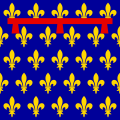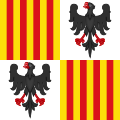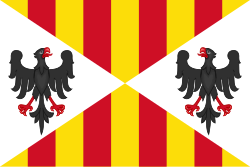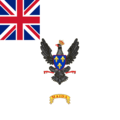 Banner of Manfred, King of Sicily (r. 1258–1266)
Banner of Manfred, King of Sicily (r. 1258–1266)
 | |
| Trinacria [1] | |
| Use | Civil and state flag |
|---|---|
| Proportion | 13:20 (as shown above), 2:3 or 3:5 |
| Adopted | 4 January 2000 |
| Design | Divided diagonally from the upper hoist-side corner; the upper triangle is red and the lower triangle is yellow; in the center is the Sicilian triskelion featuring the winged head of Medusa with three ears of wheat protruding from it. |
The flag of Sicily [a] shows a triskeles symbol (a figure of three legs arranged in rotational symmetry), and at its center a Gorgoneion (depiction of the head of Medusa) with a pair of wings and three wheat ears. In the original flag, the wheat ears did not exist and the colors were reversed. The original flag was created in 1282 during the rebellion of the Sicilian Vespers.[ citation needed ]












